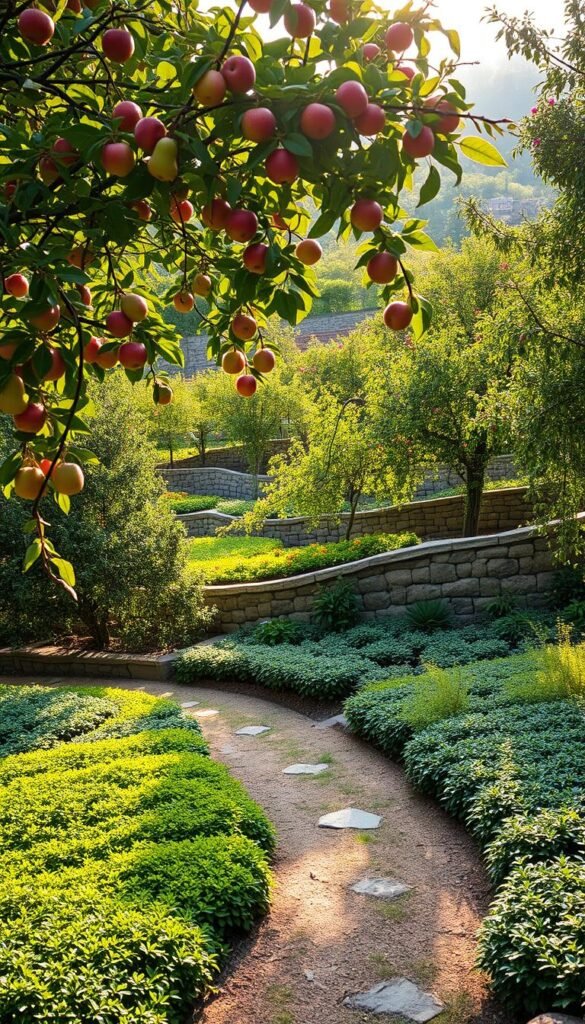What if your steep, tricky terrain could become your home’s most productive feature? Many homeowners see slopes as obstacles, but these spaces hold untapped potential. With smart planning, even a 50% gradient slope—like one transformed from a 6-foot drop over 10.5 feet—can bloom into lush, terraced beds bursting with fresh produce.
You’ll learn how to turn challenging angles into thriving growing zones. Terraced setups naturally prevent soil erosion while creating microclimates perfect for fruit trees and berry bushes. One gardener’s first-season journey proves it’s possible to go from bare slope to bountiful harvests with the right approach.
This guide focuses on practical solutions for all skill levels. Discover how to assess sunlight patterns, drainage needs, and structural support for your specific incline. We’ll explore budget-friendly methods to build retaining walls and maximize vertical space without professional help.
By repurposing underused land, you’ll gain more than just fresh snacks. These projects often boost property value and create stunning outdoor living areas. Ready to transform that hillside into a delicious, eye-catching asset?
Understanding the Unique Challenges of Sloped Yards
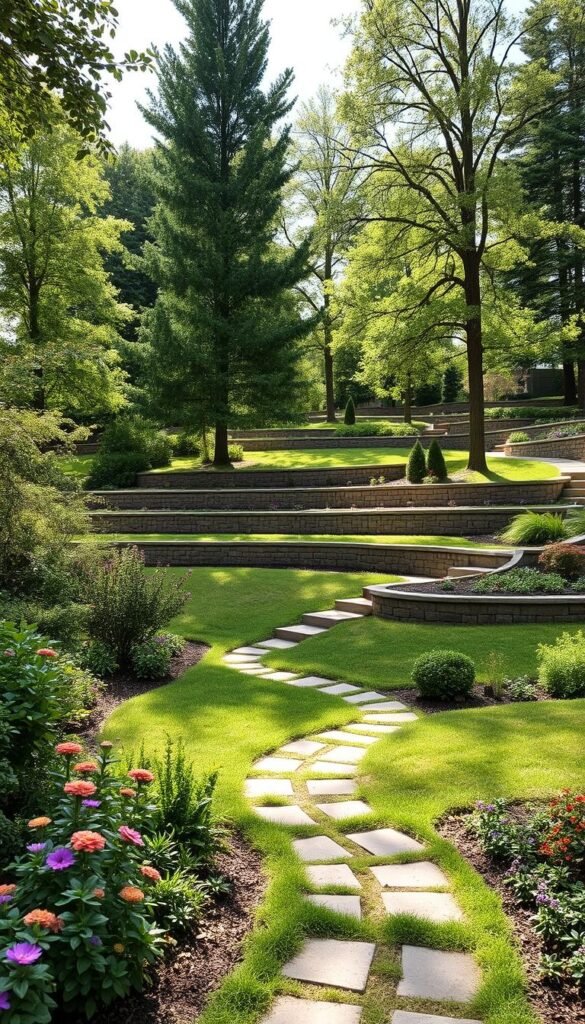
Working with a slope offers exciting possibilities but demands careful planning. Your hillside’s angle and soil composition create distinct growing conditions requiring tailored solutions. Let’s break down the key factors influencing your success.
When Water Works Against You
Slopes can turn rainfall into either a blessing or a curse. Steep angles send water racing downhill before roots absorb it, leaving thirsty plants in its wake. Yet pooling at the base creates swampy zones where roots drown. Observe your land after storms – fast-moving streams and soggy patches reveal where to install drainage or retention systems.
Reading the Land’s Natural Language
That 50% gradient slope? It’s a different story than gentle inclines. Steep slopes need terraced beds to prevent soil loss, while milder angles might only require strategic planting. Track sunlight patterns too – morning shadows on eastern slopes versus afternoon baking on western faces determine which plants thrive where.
Check erosion hotspots after heavy rains. Exposed roots or sediment trails show where wind and rain steal your topsoil. These areas need quick fixes like groundcover plants or rock barriers. Remember: every slope has unique needs based on its steepness, soil type, and sun exposure.
Benefits of a Terraced Landscape for Your Garden
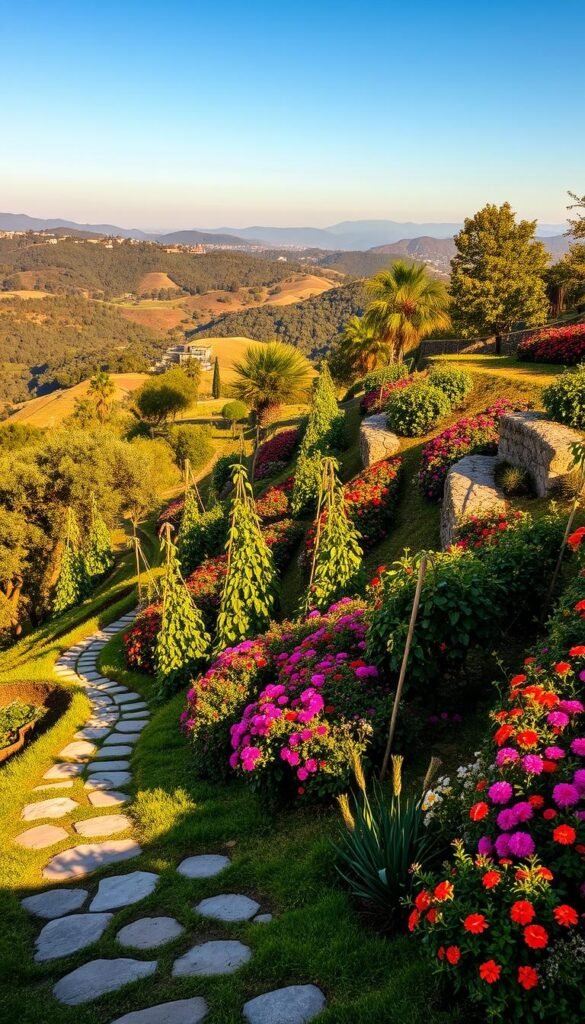
Steep slopes don’t have to limit your green thumb ambitions. Terraced gardens unlock hidden potential by converting tricky inclines into organized planting zones. This approach lets you triple your growing area compared to flat layouts while keeping soil firmly in place.
Maximizing Usable Space on a Slope
Terracing turns vertical challenges into opportunities. Upper levels naturally drain water to lower tiers, creating ideal conditions for moisture-loving plants below. You can create a terrace garden in a sloped using stone, timber, or recycled materials for a custom look that fits your space.
Multi-level designs let you grow sun-hungry fruits at the top and shade-tolerant herbs farther down. This stacking effect mimics natural ecosystems, where taller plants protect smaller ones from wind and frost. Maintenance becomes simpler too – no more balancing on uneven ground while pruning or harvesting.
Beyond practicality, terraced layouts add striking visual depth to your landscape. The clean lines of raised beds transform chaotic slopes into inviting outdoor rooms. You’ll gain both beauty and bounty without fighting your land’s natural contours.
Planning Your Retaining Walls and Garden Beds
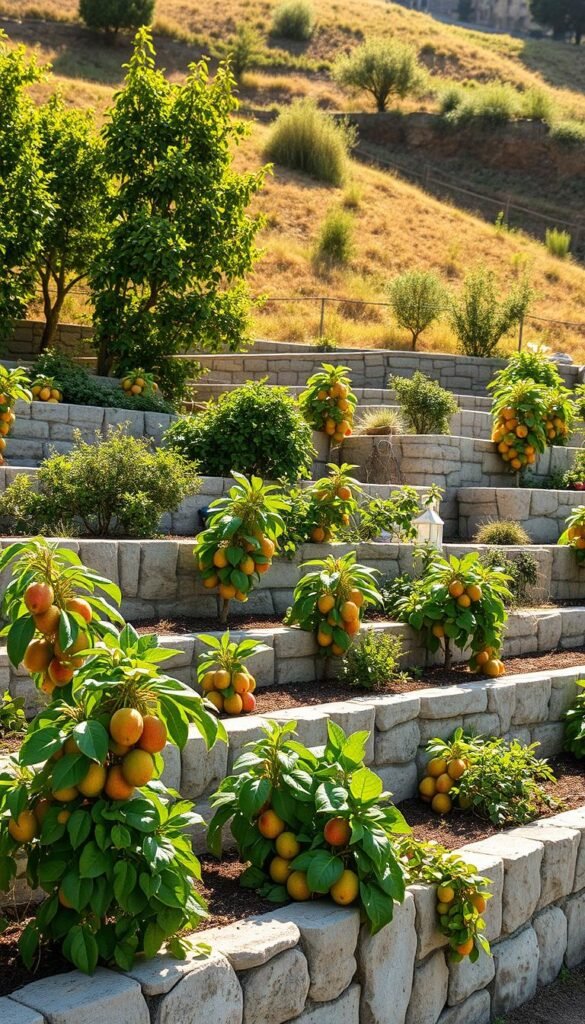
Building strong foundations starts with smart design. Retaining walls do more than hold soil – they shape your landscape’s personality while protecting your plants. Let’s explore how to balance strength and style for lasting results.
DIY Retaining Wall Considerations
One landscape architect learned this firsthand:
“Building our first retaining wall tested every skill – and our marriage!”
Their $3,000 project succeeded through detailed planning with a budget template. Cold March weather added challenges, proving timing matters as much as technique.
Ask yourself three questions before starting:
- Can I lift heavy materials daily?
- Does my schedule allow for weather delays?
- Do local codes require permits for walls over 3 feet?
Choosing Materials for Stability and Aesthetics
Options range from rustic timber ($10/sq ft) to sleek concrete ($50/sq ft). Natural stone offers timeless charm but needs precise fitting. Gabion walls (wire cages filled with rocks) provide modern flair with built-in drainage.
Key factors when selecting:
- Drainage: Add gravel backfill to prevent water pressure
- Root space: Leave 18-24″ between walls for mature plants
- Frost depth: Dig foundations 12″ below your area’s freeze line
Remember: The right materials turn slopes into opportunities. Your walls become both functional artwork and plant protectors.
Fruit Garden Design Tips for Sloped Yards and Terraced Landscapes
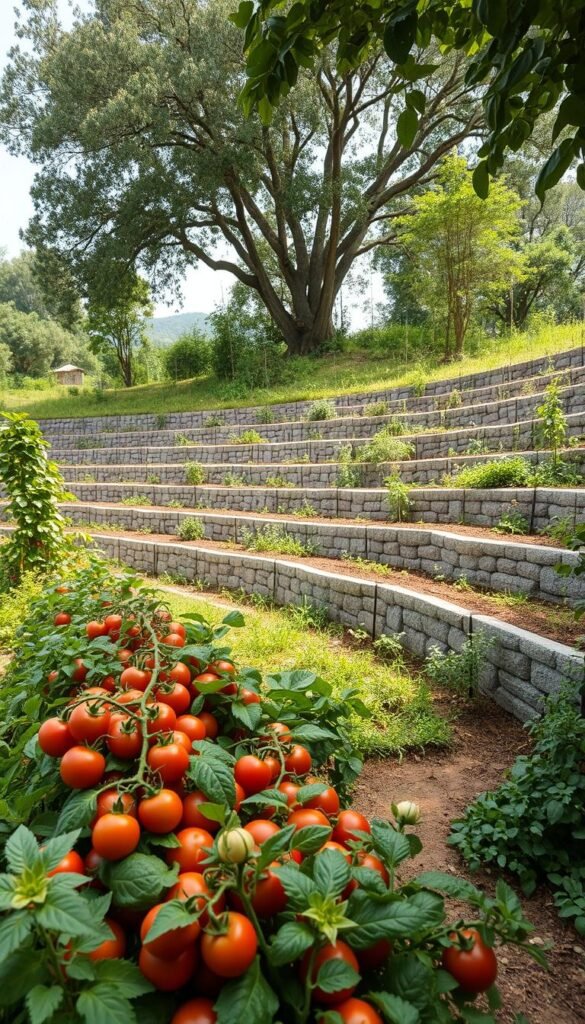
Your sloped terrain becomes a canvas for creative cultivation when you layer plants strategically. By combining vertical elements with thoughtful pairings, you’ll transform challenging angles into productive ecosystems. Let’s explore how to make every terrace level work harder for your harvest.
Integrating Vertical Gardening Strategies
Train vining crops like tomatoes and beans to climb trellises anchored between terrace levels. This approach saves ground space while improving air circulation – crucial for preventing diseases in humid microclimates. Try these space-smart solutions:
- Install A-frame structures for melons or cucumbers on upper terraces
- Use tall bamboo poles to guide indeterminate tomato varieties upward
- Attach wire grids to retaining walls for strawberries or passionfruit
The gardener’s success with six tomato varieties proves vertical systems boost yields. Their Better Boy Hybrid and Black Cherry tomatoes thrived when trained above clay soil beds.
Balancing Fruit, Vegetables, and Companion Plants
Pair dwarf apple trees with garlic clusters at their base – the allium scent deters borers while maximizing terrace space. Follow these pairing principles:
- Plant marigolds beside squash to repel cucumber beetles
- Grow basil near stone fruits to improve flavor and attract pollinators
- Use chives as edging plants to discourage aphids in berry patches
Coarse soil areas become perfect homes for blueberry bushes needing acidic conditions, while clay-rich terraces support deep-rooted vegetables like carrots. This layered approach creates natural pest control and continuous harvests from spring through fall.
Optimizing Soil Health and Irrigation Techniques
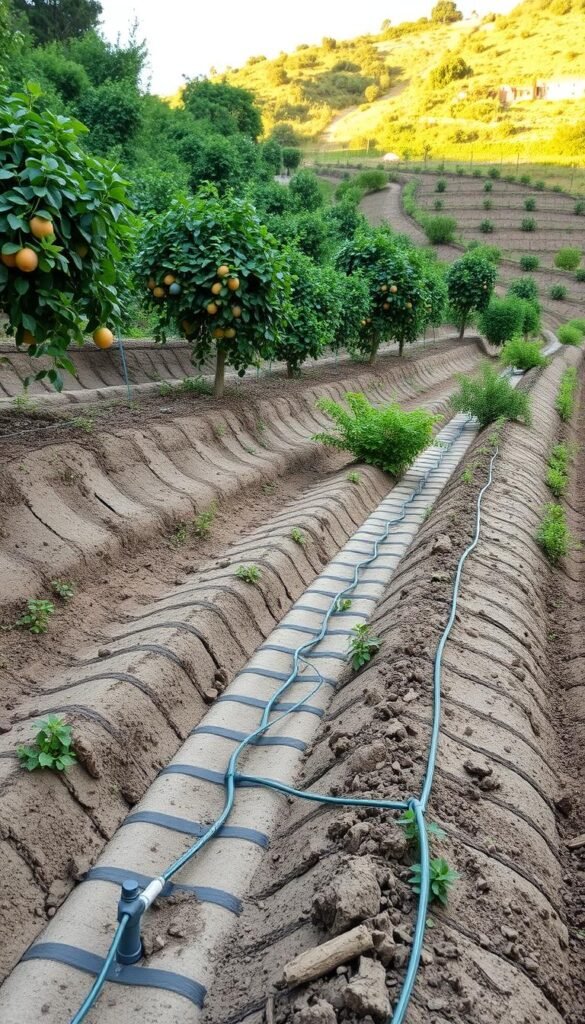
Healthy growth starts below the surface. Proper soil management and smart watering systems work together to create thriving planting areas on slopes. Let’s explore how to build strong foundations for your greenery.
Let Earth Breathe Before Planting
Newly filled beds need time to stabilize. One gardener learned this the hard way:
“Our soil level dropped inches after planting. Seeds shifted like marbles on a tilted table!”
Follow this three-step process for even surfaces:
- Wait 3-4 weeks after filling beds
- Add 15% extra soil to account for settling
- Test compaction by walking across – footprints shouldn’t sink deeper than 1″
Water Smart, Not Hard
Slopes demand precision watering. Drip systems deliver moisture directly to roots while preventing runoff. Consider these components for efficient setups:
| Component | Function | Cost |
|---|---|---|
| Programmable timer | Automates watering schedule | $25-$80 |
| Adjustable drip lines | Controls flow per plant | $0.50/ft |
| Pressure regulator | Maintains steady flow | $10-$30 |
Modular kits let you expand systems as plants grow. Connect lines along terrace edges for full coverage. Pair with moisture sensors to prevent overwatering – they’ll alert you when soil reaches ideal dampness.
Creating Accessible Paths and Structural Supports
Navigating your multi-level growing space safely requires smart pathway planning. Well-designed walkways let you care for plants without trampling them, while sturdy supports keep vertical elements secure. Let’s explore how to balance practicality with visual appeal.
Designing Walking Paths and Step Platforms
Path width matters more than you think. Aim for 24-36 inches to move comfortably between levels. One family reused retaining wall blocks for paths, saving money while matching their home’s landscape. Their toddler-friendly design proves even narrow routes work when thoughtfully planned.
Choose materials that handle foot traffic and weather. Crushed gravel drains well, while pavers offer stability. For steep transitions, install steps with 6-inch rises and 12-inch depths. Add railings if slopes exceed 30 degrees – safety first!
Don’t forget structural reinforcements. Trellises anchored to walls support climbing plants without stealing ground space. These dual-purpose features turn hard work into lasting beauty, proving function and form can grow side by side.

